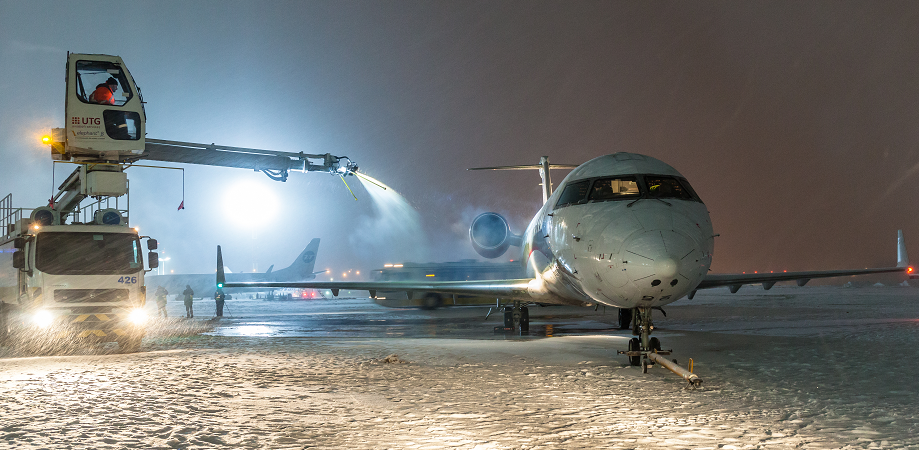Presented by Sofema Aviation Services (SAS) www.sassofia.com
The following notes are focused primarily on Flight Crew Interface & Activities related to Aircraft Ground De-Ice / Anti-Ice Operations.
General Concerns / Observations – If there are any concerns as to whether the aircraft has frozen contamination, you should request de-icing.
- Never assume that snow will blow off plus there could be a layer of ice under it.
- In rainy conditions with Outside Air Temperature (OAT) near freezing, never assume that raindrops on surfaces have remained liquid and will flow off as they could have frozen.
- A similar issue can occur due to cold-soaked fuel in the wing tanks.
- Take off with a light coating of frost (up to 1⁄8 inch [3 millimetres] thick) on lower wing surfaces caused by cold fuel is allowable. However, all leading-edge devices, all control surfaces, the horizontal tail, vertical tail, and the upper surface of the wing must be free of snow, ice, and frost.
Effective De-icing is Essential – The use of hot water or Type i fluid to clean the wing prior to the application of thickened anti-icing fluid (i.e., Type ii, iii, or iV) is even more important than previously thought due to the potential of residue build-up.
APU Operations – Operate the APU only when necessary during de-icing /anti-icing activities are taking place.
Wing Anti-Ice – Do not operate the wing anti-ice system on the ground when thickened fluids (e.g., SAE Type II, III, or IV) have been applied.
- Never use the wing anti-ice system as an alternative method of ground de-icing/anti-icing.
Aircraft Flaps Setting During Taxying – If the taxi route is through the ice, snow, slush, or standing water, or if precipitation is falling with temperatures below freezing, taxi out with the flaps up. (Taxiing with the flaps extended subjects flaps and flap devices to contamination.)
Flying Controls Freedom of Movement – Check the flight controls and flaps to ensure freedom of movement.
Engine Fan Blade Contamination
- Ice that has accumulated on the fan blades while the airplane has been on the ground for a prolonged stop is called “ground-accumulated ice” and must be removed before the engine start.
- Ice that has accumulated on the fan blades while the engine is at idle speed is called “operational ice” and is allowed to remain on the fan blades before taxi because the ice will be removed by engine run-ups prior to take-off.
During Taxi – This guidance is applicable for normal operations using all engines during taxi.
- Allowing greater than normal distances between airplanes while taxiing will aid in stopping and turning in slippery conditions.
- This will also reduce the potential for snow and slush being blown and adhering onto the airplane or engine inlets.
- Taxi at a reduced speed. Taxiing on slippery taxiways or runways at excessive speed or with strong crosswinds may cause the airplane to skid.
- Use smaller nose-wheel steering and rudder inputs. limit thrust to the minimum required.
- Use of differential engine thrust assists in maintaining airplane momentum through a turn. When nearing turn completion, placing both engines at idle thrust reduces the potential for nose-wheel skidding.
- Differential braking may be more effective than nose-wheel steering on slippery or contaminated surfaces.
- Nose-wheel steering should be exercised in both directions during taxi. This circulates warm hydraulic fluid through the steering cylinders and minimizes the steering lag caused by low temperatures.
During Engine Starting
- Perform the normal engine start procedures but note that oil pressure may be slow to rise.
- Displays may require additional warm-up time before engine indications accurately show changing values.
- Displays may appear less bright than normal.
- Engine anti-ice must be selected immediately after all engines are started, and it must remain on during all ground operations when icing conditions exist or are anticipated. (Do not rely on airframe visual icing cues before activating engine anti-ice. Use the temperature and visible moisture criteria.)
Next Steps
Follow this link to our Library to find & Download related documents for Free.
Sofema Aviation Services (SAS) and Sofema Online (SOL) provide EASA Regulatory Compliant and Vocational training delivered as classroom, webinar, and online certificated courses – for details please see the websites www.sassofia.com & www.sofemaonline.com or email team@sassofia.com
Tags:
Aircraft, Aircraft Anti-icing, Aircraft De-icing, Aircraft Ground De-Ice, Anti Icing Fluids, Anti-Ice Operations, aviation, Flight Crew, SAS blogs




